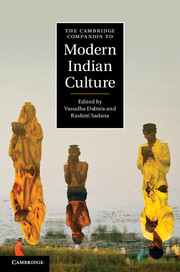Book contents
- Frontmatter
- Introduction
- Part I Cultural contexts
- Part II Cultural forms
- 6 The Bengali novel
- 7 Writing in English
- 8 Dalit life stories
- 9 National tradition and modernist art
- 10 Mass reproduction and the art of the bazaar
- 11 Urban theatre and the turn towards ‘folk’
- 12 Aesthetics and politics in popular cinema
- 13 Musical genres and national identity
- 14 Voyeurism and the family on television
- Further reading
- Index
- Cambridge Companions to Culture
8 - Dalit life stories
from Part II - Cultural forms
Published online by Cambridge University Press: 28 May 2012
- Frontmatter
- Introduction
- Part I Cultural contexts
- Part II Cultural forms
- 6 The Bengali novel
- 7 Writing in English
- 8 Dalit life stories
- 9 National tradition and modernist art
- 10 Mass reproduction and the art of the bazaar
- 11 Urban theatre and the turn towards ‘folk’
- 12 Aesthetics and politics in popular cinema
- 13 Musical genres and national identity
- 14 Voyeurism and the family on television
- Further reading
- Index
- Cambridge Companions to Culture
Summary
Not long ago, in Khairlanji, a nondescript rural town in the western Indian state of Maharashtra's Bhandara district, often called the state's ‘rice bowl’, Surekha Bhotmange, a Dalit woman in a neo-Buddhist household was getting ready to cook dinner for her family. Her husband, Bhaiyalal, was due to return from the paddy field on which he toiled each day. Her three teenage children, Priyanka, Sudhir and Roshan, were studying nearby, a sight that must have been a source of daily cheer for Surekha. She herself had studied up to the ninth standard and had taken to heart Dr B. R. Ambedkar's call for the Untouchable castes to educate their children. Priyanka cycled to her college in a nearby town. The previous year she had topped her class in the tenth standard. But that evening, on 29 September 2006, Surekha and Priyanka were anxious about an unspoken horror hovering on their threshold. While they had over the years grown immune to the everyday taunts of their upper-caste neighbours, they found that they could not ignore the crescendo of threats that had descended upon them in recent days. At 6.30 p.m. their worst fears came true. A truck came to an ominous halt in front of their home and sixty-odd villagers including women, armed with cycle chains, knives, sticks and axes, got out. They rushed in to drag Surekha and her three children from their home.
- Type
- Chapter
- Information
- The Cambridge Companion to Modern Indian Culture , pp. 142 - 162Publisher: Cambridge University PressPrint publication year: 2012
- 3
- Cited by



